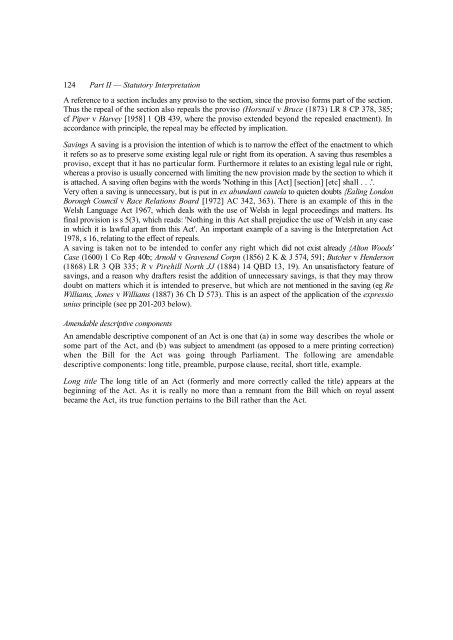Statutory Interpretation The Technique of Statutory ... - Francis Bennion
Statutory Interpretation The Technique of Statutory ... - Francis Bennion
Statutory Interpretation The Technique of Statutory ... - Francis Bennion
You also want an ePaper? Increase the reach of your titles
YUMPU automatically turns print PDFs into web optimized ePapers that Google loves.
124 Part II — <strong>Statutory</strong> <strong>Interpretation</strong><br />
A reference to a section includes any proviso to the section, since the proviso forms part <strong>of</strong> the section.<br />
Thus the repeal <strong>of</strong> the section also repeals the proviso (Horsnail v Bruce (1873) LR 8 CP 378, 385;<br />
cf Piper v Harvey [1958] 1 QB 439, where the proviso extended beyond the repealed enactment). In<br />
accordance with principle, the repeal may be effected by implication.<br />
Savings A saving is a provision the intention <strong>of</strong> which is to narrow the effect <strong>of</strong> the enactment to which<br />
it refers so as to preserve some existing legal rule or right from its operation. A saving thus resembles a<br />
proviso, except that it has no particular form. Furthermore it relates to an existing legal rule or right,<br />
whereas a proviso is usually concerned with limiting the new provision made by the section to which it<br />
is attached. A saving <strong>of</strong>ten begins with the words 'Nothing in this [Act] [section] [etc] shall . . .'.<br />
Very <strong>of</strong>ten a saving is unnecessary, but is put in ex abundanti cautela to quieten doubts {Ealing London<br />
Borough Council v Race Relations Board [1972] AC 342, 363). <strong>The</strong>re is an example <strong>of</strong> this in the<br />
Welsh Language Act 1967, which deals with the use <strong>of</strong> Welsh in legal proceedings and matters. Its<br />
final provision is s 5(3), which reads: 'Nothing in this Act shall prejudice the use <strong>of</strong> Welsh in any case<br />
in which it is lawful apart from this Act'. An important example <strong>of</strong> a saving is the <strong>Interpretation</strong> Act<br />
1978, s 16, relating to the effect <strong>of</strong> repeals.<br />
A saving is taken not to be intended to confer any right which did not exist already {Alton Woods'<br />
Case (1600) 1 Co Rep 40b; Arnold v Gravesend Corpn (1856) 2 K & J 574, 591; Butcher v Henderson<br />
(1868) LR 3 QB 335; R v Pirehill North JJ (1884) 14 QBD 13, 19). An unsatisfactory feature <strong>of</strong><br />
savings, and a reason why drafters resist the addition <strong>of</strong> unnecessary savings, is that they may throw<br />
doubt on matters which it is intended to preserve, but which are not mentioned in the saving (eg Re<br />
Williams, Jones v Williams (1887) 36 Ch D 573). This is an aspect <strong>of</strong> the application <strong>of</strong> the expressio<br />
unius principle (see pp 201-203 below).<br />
Amendable descriptive components<br />
An amendable descriptive component <strong>of</strong> an Act is one that (a) in some way describes the whole or<br />
some part <strong>of</strong> the Act, and (b) was subject to amendment (as opposed to a mere printing correction)<br />
when the Bill for the Act was going through Parliament. <strong>The</strong> following are amendable<br />
descriptive components: long title, preamble, purpose clause, recital, short title, example.<br />
Long title <strong>The</strong> long title <strong>of</strong> an Act (formerly and more correctly called the title) appears at the<br />
beginning <strong>of</strong> the Act. As it is really no more than a remnant from the Bill which on royal assent<br />
became the Act, its true function pertains to the Bill rather than the Act.

















